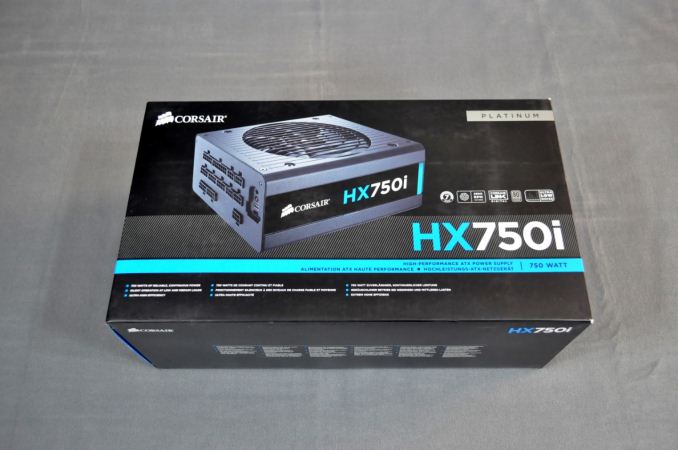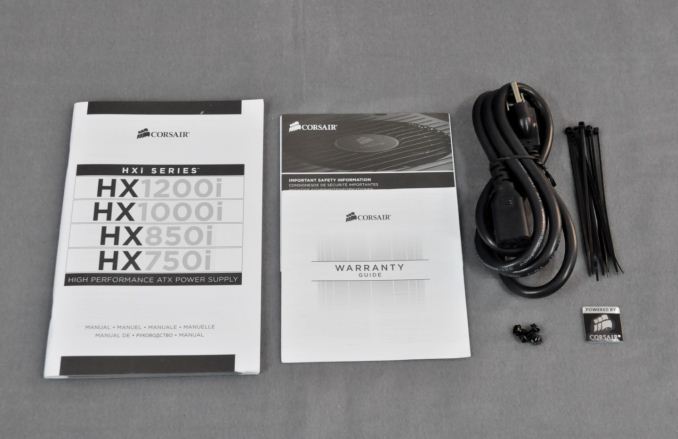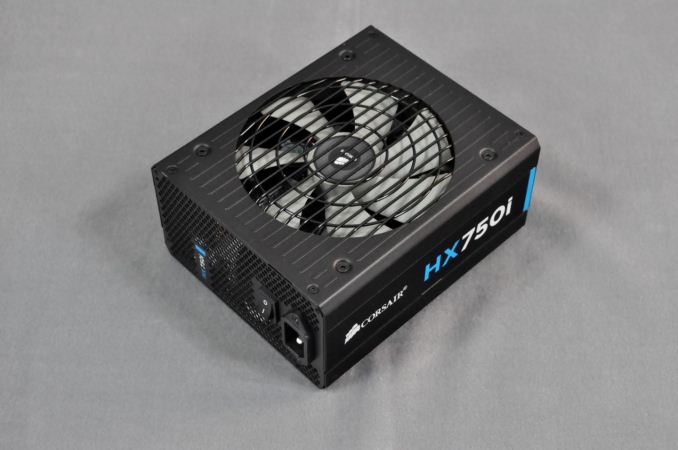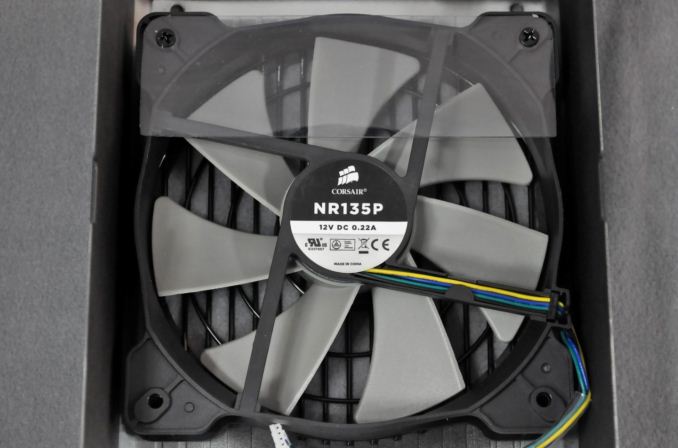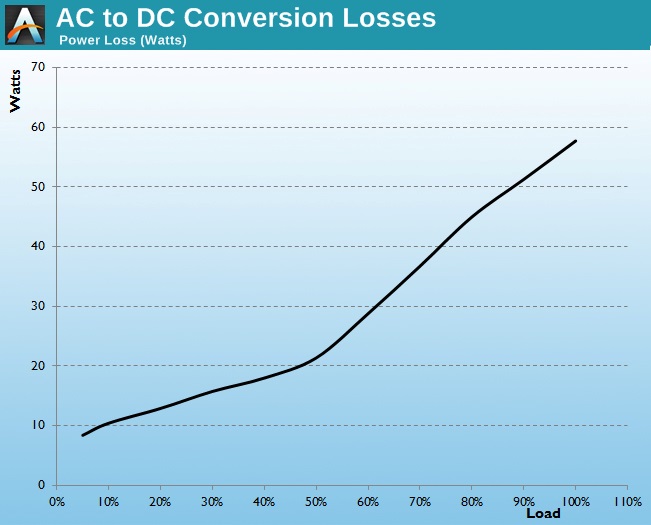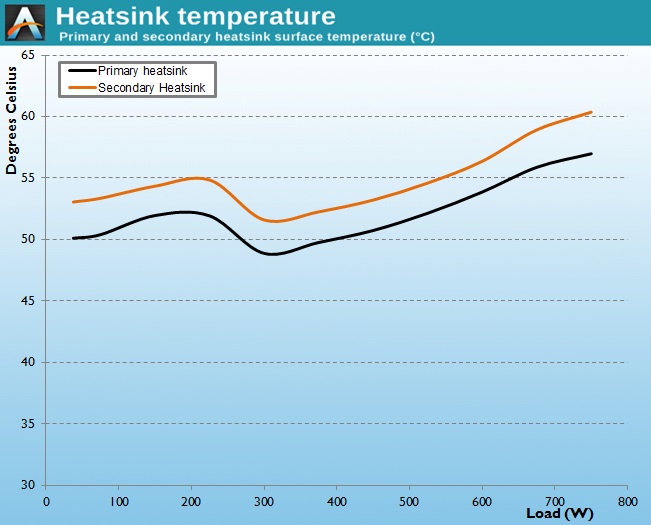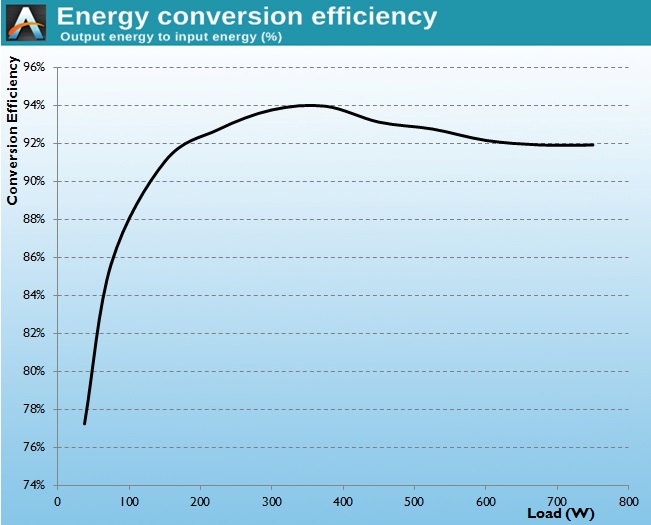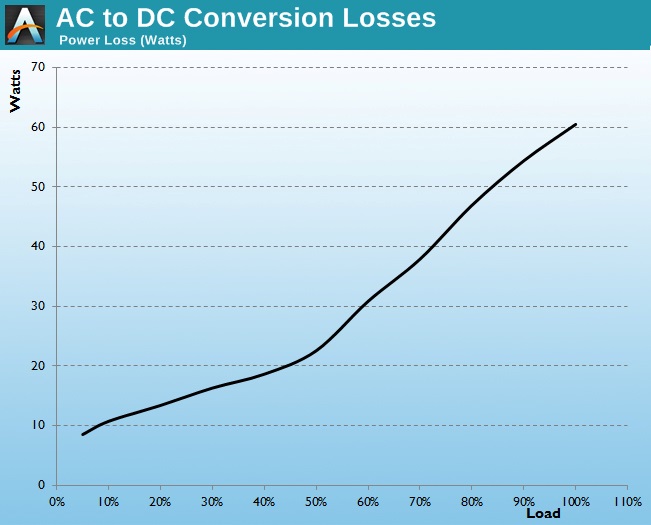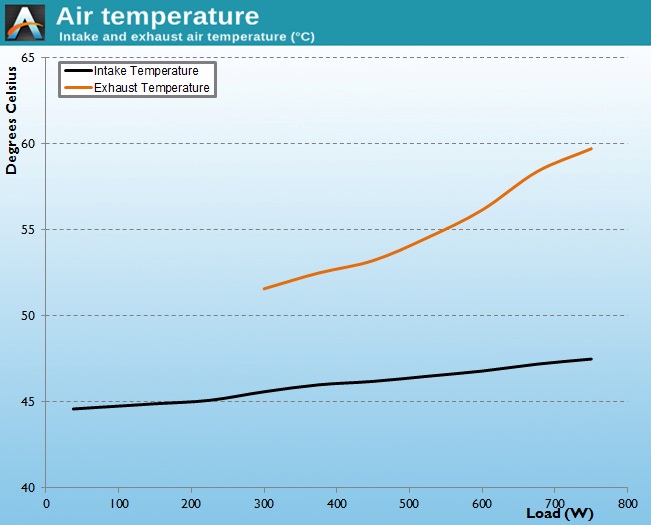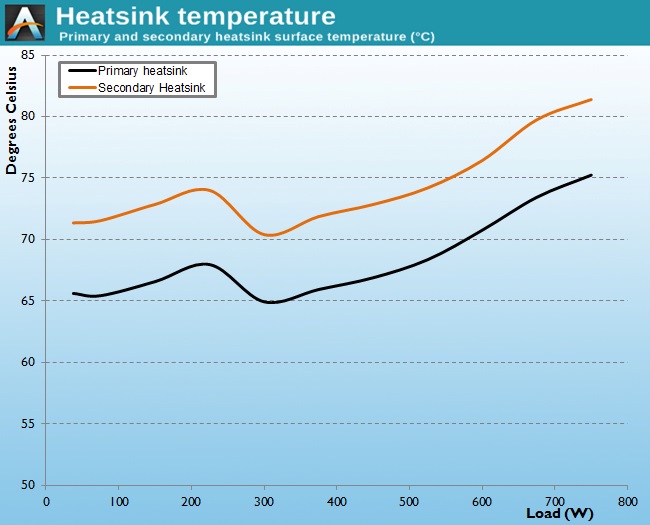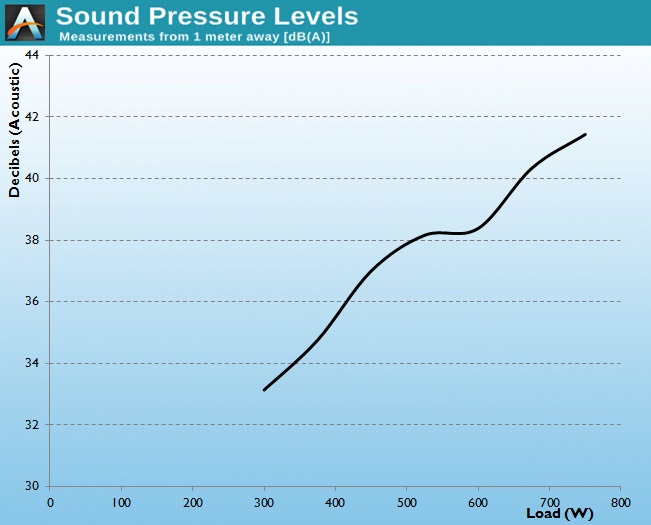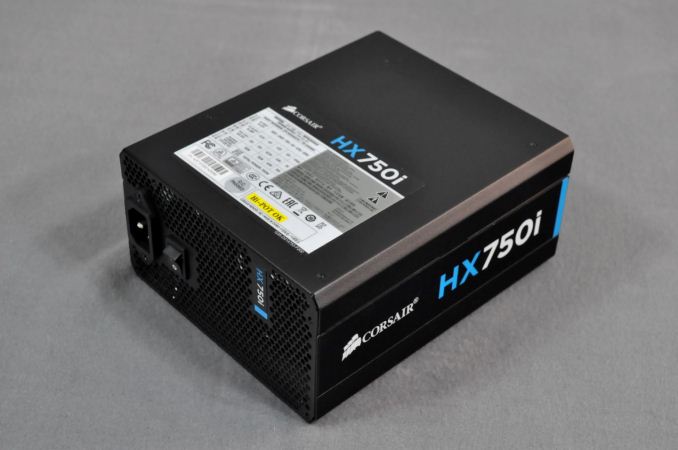
Original Link: https://www.anandtech.com/show/8835/corsair-hx750i-power-supply-review
Corsair HX750i Power Supply Review
by E. Fylladitakis on January 14, 2015 10:00 AM EST- Posted in
- Corsair
- PSUs
- Cases/Cooling/PSUs
- HXi Series
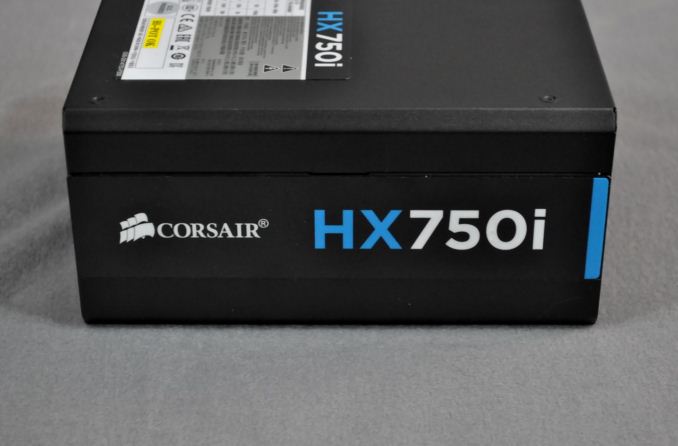
Introduction
When Corsair first diversified into the PSU market back in 2006 with the release of the HX520W and HX620W, it is likely that not even they could predict that in 2015 their company would be one of the most active players in this segment of the market. After all, Corsair's primary focus at the time was memory-related products, with the company having seemingly zero experience on power supplies. At that point, it would be extremely difficult to project that nearly nine years later Corsair would be one of the most reputable PSU brand names and would be offering dozens of products through eight different PSU series.
The people over at corsair did not limit themselves to releasing new models and series – they kept upgrading their old models as well. Today we are going to have a look at a unit from the latest revision of their HXi series, the HX750i. The HX series is of special significance to the company as it was their first PSU series. Much has changed since the first units that could barely get to 80% efficiency and had mediocre power output; the HXi series now ranges from 750 to 1000 Watts and are fully modular, digital units with an 80 Plus Platinum certification. That makes the HX750i the least powerful unit of the series and, with a retail price of $170, the least expensive one as well.
| Power specifications ( Rated @ 50 °C ) | |||||
| AC INPUT | 100 – 240 VAC, 50 – 60 Hz | ||||
| RAIL | +3.3V | +5V | +12V | +5Vsb | -12V |
| MAX OUTPUT | 25A | 25A | 62.5A | 3A | 0.8A |
| 150W | 750W | 15W | 9.6W | ||
| TOTAL | 750W | ||||
Packaging and Bundle
We received the Corsair HX750i in a relatively large cardboard box. The company opted for a straightforward, clean artwork theme for their enthusiast-grade PSU, which is mainly focused on a picture of the unit itself. The front of the box lists the most important features of the power supply, with additional details on its sides and back.
Despite the class of the power supply, the bundle is rather spartan. Corsair only includes the necessary AC power cable, four black screws, a few small cable ties, and a case sticker. There are no cable straps, thumbscrews, or any extra accessories included with the HX750i.
Every cable of the HX750i is detachable, including the 24-pin ATX cable. Corsair uses flat, ribbon-type cables with black wires everywhere, with the sole exception being the internal USB Corsair Link cable that is a typical USB cable with round black insulation.
External Appearance
Visually, the Corsair HX750i stands out from the crowd. It's housed in a 180mm long chassis, which is considerably longer than a standard ATX chassis. Such a long chassis could be a problem in compact cases designs but it is not likely that any modern ATX tower case would not have enough space to accommodate the HX750i. The body has been sprayed with a satin black paint and decorative stickers cover the largest portion of its two sides. Further aesthetic improvements include chamfered edges and embossed parallel ridges aligned with the fan's finger guard design. The sticker with the specifications of the PSU can be found on the top of the chassis (opposite the fan).
The front of the chassis is littered with the connectors for the modular cables. The CPU and PCI Express cables share the same connectors, while the split 10-14 pin connector is for the 24-pin ATX cable and the smaller connectors are for SATA/Molex cables. There are also two connectors for the Corsair Link interface, one Mini-USB for direct connection to an internal USB header or a four-pin PMBus cable for connection to a Commander unit.
Internal Design
A grey blade 135mm fan takes care of the cooling that the HX750i requires at higher loads. At lower loads and depending on the temperature, the fan of the HX750i will not operate at all. It has a rifle bearing and a maximum speed of about 1600 RPM. With the UL number pointing back to Corsair, we cannot identify the OEM of the fan, as Corsair appears to be the manufacturer of these fans.
The interior of the HX750i is where things become truly interesting. The HX750i is based on a Channel Well Technologies (CWT) design, a company that goes way back with Corsair and who built many of their earlier units. It is also nearly identical with the platform used for the RM series. The heatsinks are not much more than simple quadrangular metallic slabs with minimal heat dissipation surface, but they ought to be adequate for the cooling needs of the very efficient HX750i, especially since the same heatsinks were enough for the RM1000.
The 400V / 390μF APFC capacitors are supplied by Nippon Chemi-Con, as is every other electrolytic capacitor inside the HX750i. The polymer capacitors come from Apaq, a Taiwanese manufacturer. The quality of the components appears to be the only major improvement over the RM series, in which we found components mainly from Taiwanese manufacturers instead. The filtering stage begins at the back of the AC receptacle, where we found two of the Y capacitors. There are a total of six Y capacitors, three X capacitors, and two filtering inductors -- a reasonable amount of components for a good filtering stage.
As far as the build quality goes, CWT did a magnificent job with the HX750i. The soldering job is excellent, competing with the best that we have ever seen. If not for a little excessive use of solder at a few points, it would grade as immaculate. The factory used a lot of glue to secure most components, improving the mechanical cohesion of the unit. An extra application of lacquer and glue can be seen on the inductors, as well as heatshrink/tape covering, most likely to minimize the chance of vibration-generated noise (also known as "coil whine").
Cold Test Results
For testing PSUs, we use high precision electronic loads with a maximum power draw of 2700 Watts, a Rigol DS5042M 40 MHz oscilloscope, an Extech 380803 power analyzer, two high precision UNI-T UT-325 digital thermometers, an Extech HD600 SPL meter, a self-designed hotbox, and various other bits and parts. For a thorough explanation of our testing methodology and more details on our equipment, please refer to our How We Test PSUs – 2014 Pipeline post.
Honoring its 80 Plus Platinum certification, the Corsair HX750i displays outstanding performance at room temperature. The peak efficiency is 94.3% at 50% load and the average within the nominal load range (20% to 100% of the unit's capacity) is an astonishing 92.9%. The HX750i performs well under low loads as well, with the efficiency plummeting only when the load is less than 50 Watts.
The very high efficiency of the HX750i combined with the hybrid fan design allows the HX750i to operate with its fan turned off with a load up to about 300 Watts. After that, the fan will start but the power supply will remain essentially quiet with a load up to 600 Watts. Only when the load exceeds that point does the fan becomes clearly audible, yet it never reaches the point where we would consider it loud -- especially if it's housed in a closed case.
Hot Test Results
As the numbers in the following tables depict, the Corsair HX750i offers great power quality and maintains its superb electrical performance when subjected to high ambient temperatures. Our instrumentation recorded a maximum ripple of 40mV on the 12V line, a very good performance figure and slightly better than that of the RM1000 under the same load, despite the fact that both units are based on essentially the same platform. The voltage regulation is excellent, with the 12V line staying within 1.4% and the 3.3V/5V lines within just 1.2%.
| Main Output | ||||||||
| Load (Watts) | 151.88 W | 377.66 W | 563.6 W | 749.05 W | ||||
| Load (Percent) | 20.25% | 50.35% | 75.15% | 99.87% | ||||
| Line | Amperes | Volts | Amperes | Volts | Amperes | Volts | Amperes | Volts |
| 3.3 V | 3.92 | 3.35 | 9.79 | 3.34 | 14.69 | 3.32 | 19.58 | 3.31 |
| 5 V | 3.92 | 5.05 | 9.79 | 5.03 | 14.69 | 5 | 19.58 | 4.99 |
| 12 V | 9.79 | 12.15 | 24.48 | 12.08 | 36.72 | 12.02 | 48.96 | 11.98 |
| Line | Regulation (20% to 100% load) |
Voltage Ripple (mV) | |||||
| 20% Load | 50% Load | 75% Load | 100% Load | CL1 12V |
CL2 3.3V + 5V |
||
| 3.3V | 1.2% | 8 | 12 | 20 | 24 | 10 | 28 |
| 5V | 1.2% | 10 | 14 | 22 | 26 | 12 | 28 |
| 12V | 1.4% | 16 | 22 | 36 | 40 | 38 | 22 |
High ambient temperatures do have a negative impact on the electrical performance of the HX750i, but that impact is relatively small for a 750W PSU. The average nominal load (20-100%) efficiency drops by 0.3% and the maximum efficiency goes down to 94.0% at 50% load. Even though just barely, the Corsair HX750i could maintain its 80 Plus Platinum certification during this test as well, with an ambient temperature over 20°C higher than that of the 80 Plus testing requirements.
Strangely, even with a high ambient temperature, the fan of the Corsair HX750i starts at exactly the same point, meaning that the PSU will operate fanless with a load lower than 300 Watts regardless of the ambient conditions. Once the fan starts however, its speed will increase faster than in the previous test, making the HX750i noticeable with a load of 450 Watts, but the PSU still generates very little noise for a 750W unit even under maximum stress, with a maximum noise level of just under 42 dB(A).
Conclusion
Our opinion regarding the performance of the new HX750i can be summarized in one word – excellent. It is apparent that Corsair strives to uphold the reputation of the HX PSU series, which may not be their most advanced series anymore but it remains of special significance to the company. The HX750i that we reviewed here today may be the least powerful unit of the HXi series but it remains capable of easily powering a dual GPU gaming system or an advanced professional setup. With a reasonable power output and outstanding performance, the HX750i appeals to enthusiasts that wish to power typical performance and gaming computers but not triple or quad GPU monsters. Furthermore, the HX750i is visually subtle but appealing, and modular with all-black wires for every device, features that advanced system builders and modders will certainly appreciate.
In terms of quality, the HX750i does not disappoint at all. Essentially, the HX750i appears to be a "reinforced" version of the RM series high output units. Both units are based on the same platform and make use of the same cooling fan, but the components used to create the HX750i are of excellent quality – not that the RM series' components are bad, but moving to all-Japanese electrolytic capacitors tends to be reassuring for users. CWT does an excellent job on the assembly of the unit as well, as we cannot find any significant soldering or mechanical cohesion flaws. Corsair covers the HXi units with a seven-year warranty.
As for the performance of the PSU, the numbers speak for themselves. The HX750i is a unit that easily honors its 80 Plus Platinum certification, even when subjected to high ambient temperatures. The quality of the output is great, with superb voltage regulation and very good ripple suppression. Finally, the high efficiency results in low operating temperatures, which in turn result in very low noise.
In fact, the HX750i operates without its fan at loads lower than 300 Watts, meaning that the fan of the PSU will most likely remain off for as long as the system is performing typical everyday tasks, such as browsing the net, listening to music, or watching movies. Even when the fan starts, it never becomes annoyingly loud, not even when the HX750i is forced to operate at maximum load for prolonged periods. Inside a system capable of pushing a 750W PSU this hard, it is unlikely that the sound coming from the PSU would be noticeable over the noise generated by the cooling systems of the components.
There is really only one issue with the HX750i – the retail price of $170 is quite steep, even considering its performance and features. There are not many 80 Plus Platinum 750W-760W units currently available and the Corsair HX750i is the most expensive of them all. The strange part is that the AX760i, a unit with even better performance and more features, currently retails for $164 after rebate, making the very existence of the HX750i a strange situation.
It appears that Corsair shot themselves in the foot, as there is no reason not to prefer the AX760i to the HX750i, not even if the AX760i is selling at $184 without any rebate, let alone while it is cheaper than the HX750i. For a few weeks before Christmas, the HX750i was available for $130 after rebate, a much more reasonable price for this unit and strategically priced between the AX760i and the RM750. If the price falls to that point again, then the HX750i would be a good option for those seeking a PSU with a little better performance than an RM750 and greater value than an AX760i.
As long as the price of the HX750i remains near (let alone above) the price of an AX760i, there is no real reason for anyone not to go with an AX760i instead. It offers slightly better performance in a more compact chassis, with the result being that there's a lot of overlap right now. Eventually we expect the HX750i to end up priced right between the AX760i and HM750, closer to the $150 price point; considering both the HM750 and AX760i are selling well below MSRP while the HX750i remains at MSRP, it's bound to happen, and when it does the HX750i becomes a much better value proposition for those looking for an excellent 80 Plus Platinum PSU.

